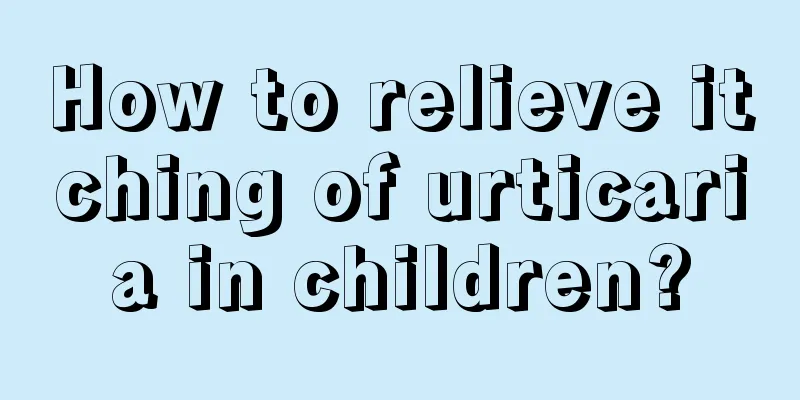How to relieve itching of urticaria in children?

|
Children's urticaria is a very common childhood skin disease in daily life. It is also called roseola or rash. It will cause hard bumps on the skin, causing redness, swelling and itching of the skin. It can also easily lead to some skin complications. Urticaria in children can easily cause severe itching of the skin. The itching can be relieved by rinsing with clean water, and some Chinese medicine prescriptions can be used for treatment. How to relieve itching of urticaria in children? If the itching is severe, you can rinse it with clean water and apply some ointment. It needs timely treatment. What is urticaria in children Infantile urticaria, commonly known as urticaria, is a common allergic skin disease and also a common skin disease in children. When the disease occurs, there will be wheals (groups) of varying sizes on the skin. When you touch them, you will find that they feel hard and itchy. The surface antigens of the urticaria can be seen in the pores. A slight scratch on the skin may result in a red mark slightly higher than the skin surface. This is caused by the cells and fluid in the blood vessels leaking out of the blood vessels. The wheals of the affected child appear and disappear quickly, and leave no traces in childhood, but they are prone to recurrence, possibly several times a day. Urticaria in children can occur in any part of the body. When it involves the digestive tract, nausea, vomiting, abdominal pain, and diarrhea may occur. It can also cause symptoms such as edema, chest tightness, breathlessness, suffocation, and bronchial asthma. Parents should take their children to the hospital for treatment in time. Children's urticaria folk remedies 1. Acute urticaria: mainly focus on dispelling wind, clearing heat and removing dampness. Recipe 1 Take 10 grams of Schizonepeta, 10 grams of Saposhnikovia, 30 grams of Lithospermum, 30 grams of Astragalus, 20 grams of Sophora flavescens, 20 grams of Kochia scoparia, and 20 grams of Taraxacum, decocted in water. Recipe 2 10 grams of ephedra, 10 grams of cicada shell, 10 grams of forsythia, 10 grams of duckweed, 10 grams of moutan bark, 10 grams of peach kernel, and 20 grams of white moss peel, decocted in water and taken orally. You can choose either one of the above two methods to be taken orally. 2. Chronic urticaria: repeated attacks can lead to blood deficiency, which can cause wind, forming a vicious circle. Traditional Chinese medicine theory believes that "to treat wind, you must first treat the blood, and when the blood circulates, the wind will disappear." Therefore, Chinese medicine that nourishes the blood and yin should be added to the treatment. Recipe 1 20 grams of raw rehmannia, 20 grams of Polygonum multiflorum, 12 grams of Chinese angelica, 12 grams of white peony root, 10 grams of Saposhnikovia divaricata, 10 grams of Moutan bark, 10 grams of Polygonatum odoratum, 10 grams of Schizonepeta tenuifolia, 30 grams of jujube, and 30 grams of ginseng leaf. Decoction in water. The traditional Chinese medicine treatment for urticaria mainly adopts the method of oral administration. If the skin itching is unbearable, you can also use 1-2 Chinese herbal medicines such as purple-backed duckweed, Xanthium sibiricum, Schizonepeta tenuifolia, Perilla frutescens leaves, and Stemona bulbs, and boil 120 grams of each into a decoction for external washing. 30 grams of black sesame seeds and 15-30 grams of rice wine. Crush the sesame seeds, put them in a cup, add rice wine, and cover it. Steam in a pot for 15 minutes. Take sesame wine once every night before going to bed. Take 1 dose daily for 1 week. Recipe 2 15 grams of Angelica sinensis, 9 grams of Moutan bark, 9 grams of red peony root, 20 grams of Rehmannia glutinosa, 6 grams of Schizonepeta tenuifolia, 6 grams of Saposhnikovia divaricata, 3 grams of mint, 4.5 grams of cicada shell, 9 grams of safflower, 15 grams of hemp seed, and 3 grams of raw licorice. Recipe 3 The medicinal ingredients include 15 grams each of Astragalus, Polygonum multiflorum, and Atractylodes macrocephala, 12 grams each of Angelica sinensis, White Moss Peel, and Salvia miltiorrhiza (added later), 10 grams each of Red Peony Root, Saposhnikovia divaricata, and Periostracum Cicadae, 9 grams each of Bird's Tail (ground and rinsed), 6 grams each of Chuanxiong, Licorice, and Scorpion (ground and rinsed). 2 centipedes (ground). Children should use less medication. |
<<: What should I do if my baby's lips are swollen?
>>: How many days will it take for the infantile rash to go away?
Recommend
Six points to note when adding complementary food to your baby in summer
①Food hygiene is very important In summer, we sho...
What should I do if my baby always has eye mucus?
The baby always has eye mucus. Mostly it’s becaus...
What should I do if my child is a little constipated?
Every child is the apple of the eye and the treas...
What is bacterial encephalitis in children?
Bacterial encephalitis in children is also a rela...
How to treat children with fever and oral ulcers
When children catch a cold, they will have a feve...
The reason why newborns always fart
In fact, for some people who have just started to...
What are the developmental indicators of eight and a half month old babies?
Every child is an angel, and the birth of a newbo...
Winter Newborn Care
Autumn and winter are the seasons when newborns a...
What can we eat to quickly improve children’s immunity?
Every time seasons change, parents become worried...
What kind of soup should children drink in autumn?
From a medical point of view, the human body is v...
What should I do if my baby is infected with Mycoplasma pneumoniae?
Mycoplasma pneumoniae infection is a common lung ...
Does a child's fever and convulsions affect the brain?
Children belong to a vulnerable group and have ve...
Characteristics of premature babies
Premature birth has a very adverse effect on the ...
What to do when your baby picks his nose
In life, many young parents always wonder about t...
Where are the moxibustion points for children's cough?
The weather changes a lot now, so it is easy for ...









